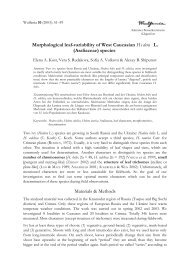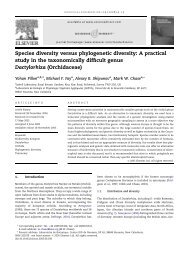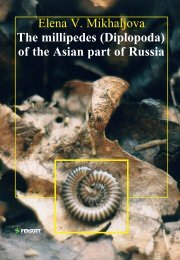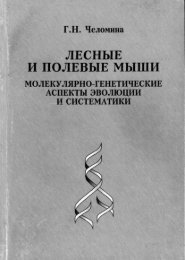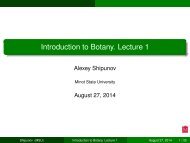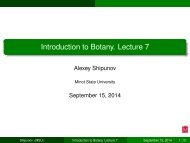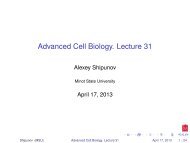Introduction to Botany. Lecture 18 - Materials of Alexey Shipunov
Introduction to Botany. Lecture 18 - Materials of Alexey Shipunov
Introduction to Botany. Lecture 18 - Materials of Alexey Shipunov
Create successful ePaper yourself
Turn your PDF publications into a flip-book with our unique Google optimized e-Paper software.
Outline1 Questions and answers2 TissuesOrigin <strong>of</strong> tissuesStep four: pipes. Vascular tissuesXylemPhloem<strong>Shipunov</strong> (MSU) <strong>Introduction</strong> <strong>to</strong> <strong>Botany</strong>. <strong>Lecture</strong> <strong>18</strong> Oc<strong>to</strong>ber 17, 2014 2 / 26
Outline1 Questions and answers2 TissuesOrigin <strong>of</strong> tissuesStep four: pipes. Vascular tissuesXylemPhloem<strong>Shipunov</strong> (MSU) <strong>Introduction</strong> <strong>to</strong> <strong>Botany</strong>. <strong>Lecture</strong> <strong>18</strong> Oc<strong>to</strong>ber 17, 2014 2 / 26
Questions and answersPrevious final question: the answerWhat is the difference between collenchyma and sclerenchyma?<strong>Shipunov</strong> (MSU) <strong>Introduction</strong> <strong>to</strong> <strong>Botany</strong>. <strong>Lecture</strong> <strong>18</strong> Oc<strong>to</strong>ber 17, 2014 3 / 26
Questions and answersPrevious final question: the answerWhat is the difference between collenchyma and sclerenchyma?Alive vs. deadPrimary vs. secondary cell walls<strong>Shipunov</strong> (MSU) <strong>Introduction</strong> <strong>to</strong> <strong>Botany</strong>. <strong>Lecture</strong> <strong>18</strong> Oc<strong>to</strong>ber 17, 2014 3 / 26
TissuesOrigin <strong>of</strong> tissuesOrigin <strong>of</strong> tissues and organs <strong>of</strong> plants: first stepsPlants were pushed on land for many reasons, includingcompetitionFirst challenge: drying. Response: epidermis and parenchyma.Second challenge: new level <strong>of</strong> competition. Response: growingup!Problem: big weight. Response: collenchyma.Competition grows, plants growing even higher. Weight grows.They also need <strong>to</strong> get rid <strong>of</strong> turgor dependency. Response: uselignin not only for epidermis surface (cuticle) but also forsecondary cell walls—sclerenchyma.Competition grows again, plants need <strong>to</strong> grow faster. Solution:meristems.Size <strong>of</strong> plant is <strong>to</strong>o big for plasmodesmata transportations.Solution: vascular tissues, xylem and phloem.<strong>Shipunov</strong> (MSU) <strong>Introduction</strong> <strong>to</strong> <strong>Botany</strong>. <strong>Lecture</strong> <strong>18</strong> Oc<strong>to</strong>ber 17, 2014 5 / 26
LigninTissuesOrigin <strong>of</strong> tissuesPhenolic compounds (e.g., lignin) were initially developed for sporedistribution with a wind, then used in cuticle, then in the secondary cell walls.<strong>Shipunov</strong> (MSU) <strong>Introduction</strong> <strong>to</strong> <strong>Botany</strong>. <strong>Lecture</strong> <strong>18</strong> Oc<strong>to</strong>ber 17, 2014 6 / 26
TissuesStep four: pipes. Vascular tissuesTissuesStep four: pipes. Vascular tissues<strong>Shipunov</strong> (MSU) <strong>Introduction</strong> <strong>to</strong> <strong>Botany</strong>. <strong>Lecture</strong> <strong>18</strong> Oc<strong>to</strong>ber 17, 2014 7 / 26
Vascular tissues: XylemTissuesStep four: pipes. Vascular tissuesOccurs in vascular bundles or vascular cylinderTypes <strong>of</strong> cells: tracheary elements (tracheids and vessel members),fibers, and parenchymaTracheids have pits; vessel members have perforations; all <strong>of</strong> them aredead cellsGymnosperms have only tracheids; flowering plants have tracheids +vessel elements <strong>to</strong>getherIn flowering plants, primary xylem has mostly tracheids and vessels withscalariform perforations; secondary xylem has mostly vessels with openperforationsXylem elements (except parenchyma) are rich <strong>of</strong> lignin and are maincomponents <strong>of</strong> woodMain functions: water transport and mechanical support<strong>Shipunov</strong> (MSU) <strong>Introduction</strong> <strong>to</strong> <strong>Botany</strong>. <strong>Lecture</strong> <strong>18</strong> Oc<strong>to</strong>ber 17, 2014 8 / 26
TissuesVessel members vs. TracheidsStep four: pipes. Vascular tissues<strong>Shipunov</strong> (MSU) <strong>Introduction</strong> <strong>to</strong> <strong>Botany</strong>. <strong>Lecture</strong> <strong>18</strong> Oc<strong>to</strong>ber 17, 2014 9 / 26
TissuesVessel members vs. TracheidsStep four: pipes. Vascular tissues<strong>Shipunov</strong> (MSU) <strong>Introduction</strong> <strong>to</strong> <strong>Botany</strong>. <strong>Lecture</strong> <strong>18</strong> Oc<strong>to</strong>ber 17, 2014 10 / 26
TracheidsTissuesStep four: pipes. Vascular tissuesPine (Pinus sp.) tracheids with pits<strong>Shipunov</strong> (MSU) <strong>Introduction</strong> <strong>to</strong> <strong>Botany</strong>. <strong>Lecture</strong> <strong>18</strong> Oc<strong>to</strong>ber 17, 2014 11 / 26
TissuesPit is NOT a direct connectionStep four: pipes. Vascular tissues<strong>Shipunov</strong> (MSU) <strong>Introduction</strong> <strong>to</strong> <strong>Botany</strong>. <strong>Lecture</strong> <strong>18</strong> Oc<strong>to</strong>ber 17, 2014 12 / 26
VesselsTissuesStep four: pipes. Vascular tissuesAsh (Fraxinus americana) secondary xylemwith vessels (LM ×26)<strong>Shipunov</strong> (MSU) <strong>Introduction</strong> <strong>to</strong> <strong>Botany</strong>. <strong>Lecture</strong> <strong>18</strong> Oc<strong>to</strong>ber 17, 2014 13 / 26
PerforationsTissuesStep four: pipes. Vascular tissues<strong>Shipunov</strong> (MSU) <strong>Introduction</strong> <strong>to</strong> <strong>Botany</strong>. <strong>Lecture</strong> <strong>18</strong> Oc<strong>to</strong>ber 17, 2014 14 / 26
TissuesStep four: pipes. Vascular tissuesScalariform perforations: direct connections<strong>Shipunov</strong> (MSU) <strong>Introduction</strong> <strong>to</strong> <strong>Botany</strong>. <strong>Lecture</strong> <strong>18</strong> Oc<strong>to</strong>ber 17, 2014 15 / 26
PhloemTissuesStep four: pipes. Vascular tissuesUsually occurs adjacent <strong>to</strong> a xylemTypes <strong>of</strong> cells: sieve tube cells, companion cells, fibers andparenchymaSieve tube cells have plastids and perforation (sieve) platesbetween cells but no nuclei, companion cells have nucleiHowever, in gymnosperms there are no companion cells and sievetube cells have nucleiSecondary phloem usually has more fibers than primary phloemMain functions: sugar transport and mechanical support<strong>Shipunov</strong> (MSU) <strong>Introduction</strong> <strong>to</strong> <strong>Botany</strong>. <strong>Lecture</strong> <strong>18</strong> Oc<strong>to</strong>ber 17, 2014 16 / 26
Phloem cell typesTissuesStep four: pipes. Vascular tissues<strong>Shipunov</strong> (MSU) <strong>Introduction</strong> <strong>to</strong> <strong>Botany</strong>. <strong>Lecture</strong> <strong>18</strong> Oc<strong>to</strong>ber 17, 2014 17 / 26
TissuesStep four: pipes. Vascular tissuesSieve tubes and phloem parenchyma<strong>Shipunov</strong> (MSU) <strong>Introduction</strong> <strong>to</strong> <strong>Botany</strong>. <strong>Lecture</strong> <strong>18</strong> Oc<strong>to</strong>ber 17, 2014 <strong>18</strong> / 26
Perforation (sieve) plateTissuesStep four: pipes. Vascular tissuesCross-section (TEM)<strong>Shipunov</strong> (MSU) <strong>Introduction</strong> <strong>to</strong> <strong>Botany</strong>. <strong>Lecture</strong> <strong>18</strong> Oc<strong>to</strong>ber 17, 2014 19 / 26
Plates: frontal viewTissuesStep four: pipes. Vascular tissuesFrontal view (LM)<strong>Shipunov</strong> (MSU) <strong>Introduction</strong> <strong>to</strong> <strong>Botany</strong>. <strong>Lecture</strong> <strong>18</strong> Oc<strong>to</strong>ber 17, 2014 20 / 26
Plates: poresTissuesStep four: pipes. Vascular tissuesSieve plate, a pore in the end wall <strong>of</strong> a sieve-tube member, throughwhich phloem sap flows (SEM ×4800)<strong>Shipunov</strong> (MSU) <strong>Introduction</strong> <strong>to</strong> <strong>Botany</strong>. <strong>Lecture</strong> <strong>18</strong> Oc<strong>to</strong>ber 17, 2014 21 / 26
TissuesPrimary vascular tissuesStep four: pipes. Vascular tissues<strong>Shipunov</strong> (MSU) <strong>Introduction</strong> <strong>to</strong> <strong>Botany</strong>. <strong>Lecture</strong> <strong>18</strong> Oc<strong>to</strong>ber 17, 2014 22 / 26
TissuesSecondary vascular tissuesStep four: pipes. Vascular tissues<strong>Shipunov</strong> (MSU) <strong>Introduction</strong> <strong>to</strong> <strong>Botany</strong>. <strong>Lecture</strong> <strong>18</strong> Oc<strong>to</strong>ber 17, 2014 23 / 26
TissuesFinal question (2 points)Step four: pipes. Vascular tissues<strong>Shipunov</strong> (MSU) <strong>Introduction</strong> <strong>to</strong> <strong>Botany</strong>. <strong>Lecture</strong> <strong>18</strong> Oc<strong>to</strong>ber 17, 2014 24 / 26
TissuesFinal question (2 points)Step four: pipes. Vascular tissuesWhat are more primitive states for xylem and phloem, respectively?<strong>Shipunov</strong> (MSU) <strong>Introduction</strong> <strong>to</strong> <strong>Botany</strong>. <strong>Lecture</strong> <strong>18</strong> Oc<strong>to</strong>ber 17, 2014 24 / 26
SummaryTissuesStep four: pipes. Vascular tissuesXylem vs. phloem:State: dead vs. living cellsTransport: water vs. sugarDirection: up vs. downBiomass: big vs. small<strong>Shipunov</strong> (MSU) <strong>Introduction</strong> <strong>to</strong> <strong>Botany</strong>. <strong>Lecture</strong> <strong>18</strong> Oc<strong>to</strong>ber 17, 2014 25 / 26
For Further ReadingTissuesStep four: pipes. Vascular tissuesA. <strong>Shipunov</strong>.<strong>Introduction</strong> <strong>to</strong> <strong>Botany</strong> [Electronic resource].2010—onwards.Mode <strong>of</strong> access:http://ashipunov.info/shipunov/school/biol_154Th. L. Rost, M. G. Barbour, C. R. S<strong>to</strong>cking, T. M. Murphy.Plant Biology. 2nd edition.Thomson Brooks/Cole, 2006.Chapter 4.<strong>Shipunov</strong> (MSU) <strong>Introduction</strong> <strong>to</strong> <strong>Botany</strong>. <strong>Lecture</strong> <strong>18</strong> Oc<strong>to</strong>ber 17, 2014 26 / 26




